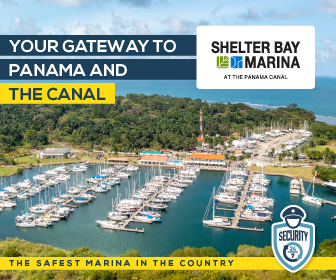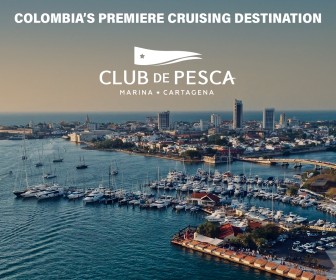Colombia, Catalina on Isla Providencia: Cruisers’ Experiences
Cruisers’ experiences of using the Bush Agency and a useful reminder of the importance of remembering the 200m error on electronic charts.
Published 11 years ago, updated 6 years ago
Posted 6th August 2013
We checked into Isla Providencia, Colombia, on July 4, 2013.
We started to enter the channel to Providencia using our Navionics electronic charts. As we approached the first set of red and green buoys, our charts showed we were heading directly for a reef. Instead of following our charts or the buoys, we used some waypoints we had from a previous cruiser and slowly made our way in.
In the channel, we contacted Bush Agency on channel 16. We were told to anchor and go to the dinghy dock. Call again from the dock and we would be met. We passed through the last set of red and green buoys and anchored to the side of the channel.
Mr Bush walked us to his office. He collected our passports, zarpe and boat registration, and said to return the next day. The cost would be $140 or 280,000 pesos. Our immigration stamp was good for 90 days and getting an extension was easy. Our cruising permit was valid for 10 days. As we needed to stay longer, this required additional paperwork but no extra cost.
Mr Bush also advised us to move our boat because although we anchored out of the north/south channel, we were directly in the middle of the east/west channel.
Note: Large ships use the north/south channel but those using the town dock make a hard right turn at the buoys and thus use the east-west channel also.
The next day we collected our passports, paid, and provided more detail for the importation. We used channel 16 for contact.
We advised Mr Bush on Friday that we planned to leave Monday and dropped off our passports. On Monday, we went to the office, signed the zarpe and collected our passports. Our next port was Bocas del Toro, Panama. We never saw the importation paperwork.
Having watched large ships, we realized the charts are way off and followed the buoys out.
Gail Johnson
s/v It’s Good To Be
————————————————————————————————————————————————————————————————————
Posted 12 December 2012
We were in Providencia, Colombia from November 21, 2012, to Nov. 29, 2012. We hailed the port captain on ch. 16 and were contacted by Mr Bush/his agency to come in for clearing in procedures.
Mr Bush had us in every day for 3 or 4 days bringing various documents (more copies of boat documents, crew lists, etc.). When asked about payment for clearing in we were always told: “don’t worry about it”. After several days of coming in to meet with Mr Bush, we were told we were cleared in but were not asked for money yet. When we left after about 1 week, Mr Bush charged us $80 US for his “services” and $30 per passport for a tourist card (although we never actually received it). We do know that we did not have a tourist card for the country, if we had travelled to another port in Colombia, that would have been an issue, but since we left, it didn’t matter.
All the other boats that arrived during our stay, experienced the same issues. We have heard that it is different (i.e. cheaper) in other ports of Colombia.
There were 4-5 other boats that also arrived while we were there, and they also experienced the same frustration and running around with Mr Bush. We knew of a boat that was able to “negotiate” a lower agency fee from Mr Bush, but we were not able to do that. We did get Mr Bush to write a receipt for us that shows what we paid for a tourist card and for his services.
We never received a cruising permit and weren’t told about one, but we did not go to any other ports in Colombia.
Name and Boat Name withheld.
————————————————————————————————————————————————————————————————————
Posted 18 February 2011
We arrived at Catalina on 24th December 2010.
There are several channels leading into the port. The primary channel is marked with six buoys and starts with the deep water buoy ACTUALLY located at 13°23.905 north and 812°3.652 west. Both of our electronic charts noted a quarter of a nautical mile offset. That is, objects were actually about a quarter of nautical mile west of their displayed electronic chart locations.
Entering the harbour is straightforward. Proceed from the deep water buoy and stay between the red and green buoys using the B System (red right return). During our visit, five of the six lighted buoys were working and we had greater than 16 feet of water throughout the channel. Just before the last red and green channel buoy turns north and anchor south of Isla Santa Catalina. The anchorage is sand and turtle grass with most yachts anchoring in 6 to 12 feet of water. We anchored in 9 feet of water at 13°22.7 north and 81°22.4 west. Avoid anchoring in the channel which leads to the concrete commercial wharf. If you do, you might be asked to move out of the way for one of the visiting island cargo ships.
Clearance
An agent is required, so upon arrival, we called “Mr Bush” on VHF channel 16 to make arrangements to clear in and out. Or, you can phone him at (578) 098-5148059. He will instruct you on when and where to meet him to complete clearance procedures.
Typically, you will take your dinghy to the dinghy dock which is located just north of the concrete commercial wharf. Make sure you have a stern anchor with you so that your dinghy doesn’t get swept under the dock. At the appointed time you will transport Mr Bush and the Immigrations officer to your vessel. While on your vessel you will give your passports to the Immigrations officer who will return them to you in several days, or on your date of departure. Mr Bush and the Immigrations officer also requires two copies of your crew list and ship’s papers. The paperwork typically takes only a few minutes and then you will return your visitors to the dinghy dock.
You can clear in as a yacht “In Transit” or seek a “Cruising Permit.” A yacht In Transit should plan on arriving one day and departing the next day. In reality, some In Transit yachts have stretched their visit to three days. If you are a yacht In Transit your next port of call should be outside of Columbia. A Cruising Permit allows you to stay at Providencia for longer than 24 hours and you can also visit other Columbian ports.
If you are a vessel “In Transit” your passports will be returned to you within 24 hours of arrival. You will get your stamped passports from Mr Bush. You will NOT receive an exit/despacho/zarpe document.
Mr Bush is available from 08:30 to 17:00, 365 days per year. His governmental contacts are also available 365 days per year.
We were not asked to declare guns, ammunition, illegal drugs, foods, pets, spearguns/slings, etc. Fees can be paid in Columbian pesos or United State dollars.
As a yacht in transit $50 USD is paid to Mr Bush. This covers all government fees and Mr Bush’s agency fee for clearing in and clearing out. Regardless of the date, day, or time, this amount is fixed. If requiring a Cruising Permit, then $110 USD is paid to Mr Bush. This covers all government fees and Mr Bush’s agency fee for clearing in and clearing out. Again, it is a fixed amount. The usual papers are required.
Security
We felt that personal and property security issues were low risk at Providencia if common sense was used during your visit.
Goods and Services
Providencia is more expensive than most Caribbean islands/nations. Near the dinghy dock, there are three grocery stores with the basics. A two-litre bottle of Coke was about $4 US dollars and a U.S. gallon of gas at the only gas station on the island was $3.90 USD. Few merchants accept U.S. Dollars, most transact in Columbian pesos. The official exchange rate is 2,000 pesos per U.S. dollar. Merchants who accept U.S. dollars will give you an exchange rate of 1,700 pesos. You can walk much of the island, rent an inexpensive scooter, or get a $1.50 USD ride on the bus (pick-up truck with two bench seats in the back). Providencia does not have a marina or boatyard.
To dispose of garbage, use the large trash drums located near the dinghy dock.
Additional Comments
Providencia is a cluster of small islands with about 5,000 local citizens. Most of the visitors to the island are from the Columbian mainland. The governmental tourist office is located several hundred feet from the dingy dock, just walk towards the Lover Lane floating bridge which connects Isla Santa Catalina to Providencia. Spanish is the primary language, however many locals also speak English.
Jason and Karen Trautz
S/V “YOLO” (You Only Live Once)
Related content
Related to following destinations: Colombia, Isla de Providencia, Off Lying Islands Caribbean (Colombia)







